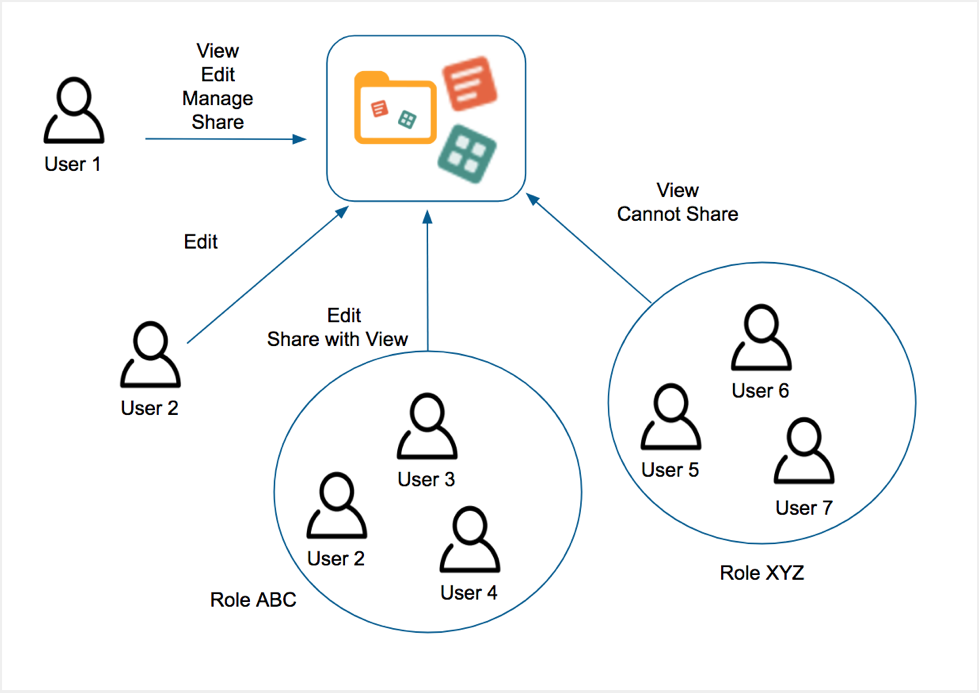As organizations scale and grow, teams begin to emerge with areas of specialization and ownership. Dependencies develop, with individuals and teams acting as service providers to other functional areas. We’re finding information technology and DevOps teams rely on Sumo Logic for not just their own monitoring of application health and infrastructure, but also for sharing this data out to other functional areas such as customer support and business analysts, to empower them to make stronger data-driven decisions. Our top customers such as Xero, Acquia and Delta each have hundreds if not thousands of users spread across multiple teams who have unique data needs that align with varying business priorities and wide ranges of skill sets.
Scaling our platform to support the data distribution and sharing needs of such a broad and diverse user base is a key driver of Sumo Logic’s platform strategy. To this end, we are excited to announce the general availability of our new Content Sharing capabilities. Underlying this updated ability to share commonly used assets such as searches and dashboards is a secure, fine-grained and flexible role-based access control (RBAC) model. Check out our intro to content sharing video for more details.
Collaboration with Control
The updated model allows for data visualization assets such as searches and dashboards to be shared out individually (or grouped in folders) to not just other users, but also to members of a particular role. Users can be invited to simply view the asset or participate in actively editing or managing it. This allows for individual users to collaborate on a search or dashboard before sharing it out to the rest of the team. When new information is discovered or a meaningful visualization is created, they can be easily added to a dashboard by anyone with edit access and and the change is made immediately available to other users.

While ease-of-use is critical in ensuring a smooth collaboration experience, it should not come at the price of data security. It is always transparent as to who has what access to an asset and this access can be revoked at any time by users with the right privileges. Users can control the data that is visible to the viewers of a dashboard and new security measures such as a “run-as” setting have been introduced to prevent viewing or exploitation of data access settings put in place by administrators.
Business Continuity
Supporting business continuity is a key conversation we have with our customers as their businesses grow and their data use-cases evolve and deepen. This new set of features reflects Sumo Logic’s belief that the data and its visualizations belong to the organization and should be easily managed as such. We’ve replaced our single-user ownership model with a model where multiple users can manage an asset (ie, view, edit and if required, delete it).
This ensures that a team member could, for example, step in and update an email-alert-generating scheduled search when the original author is unavailable. Even if the asset was not shared with other team members, administrators now have the ability (via a newly introduced “Administrative Mode”) to manage any asset in the library, regardless of whether it was actively shared with them or not.
The user deletion workflow has been simplified and updated to support business continuity. When a user is deleted, any of their searches and dashboards that are located in a shared folder continue to exist where they are, thus providing a seamless experience for team members depending on them for their business workflows. Administrators can assign and transfer the management of any assets located in the user’s personal folder to another team member with the right context. (Previously, administrators would have had to take ownership and responsibility.)
Teams as Internal Service Providers
Development teams that own a specific app or run an area of infrastructure, are increasingly seen as internal service providers, required to meet SLAs and demonstrate application health and uptime. They need to make this information easy to discover and access by field and service teams who in turn, rely on this data to support end customers.
Our newly introduced Admin Recommended section allows administrators to set up organizational folder structures that facilitate this easy interaction between producers and consumers. Relevant folders are pinned to the very top of our Library view, enabling easy discoverability to infrequent users. The contents of these folders can be managed and updated by individual development teams, without the administrator needing to intervene.
This allows for sharing of best practices, commonly used searches and dashboards as well as enables users to create team-specific best practice guides.
As data-driven decision-making becomes the norm across all job functions and industries, the Sumo Logic platform is designed to scale in performance, usability and security to meet these needs. Features like fine-grained RBAC and administrative control, coupled with intuitive design make information accessible to those who need it the most and enable the creation of workflows that democratize data and drive business growth.
Upcoming Webinars
To learn more about how these features can be applied at your organization, please sign up for one of our upcoming webinars on May 1st (2:00 p.m. PST) or May 3rd (9:00 a.m. PST)

